Part 4 of 5: Impact of COVID-19 on Students Served at College Counseling Centers
The impact of COVID-19 has led to widespread concerns about its unique effects on college students’ mental health. To examine this topic more broadly, CCMH is completing a five-part blog series using longitudinal clinical data from students seeking mental health services at college counseling centers nationally.
In Part 1, CCMH explored the role of COVID-19 in mental health help-seeking and the rates at which students reported negative impacts from COVID-19 across various aspects of their life. In Part 2, we assessed how student distress and clinician-identified problems changed nationally after the onset of COVID-19. In Part 3, CCMH investigated the negative impacts of COVID-19 across demographic groups. In this blog, Part 4 of 5, CCMH will explore how COVID-19 impacted student help-seeking and the services provided by college counseling centers. Specifically, this blog will address the following questions:
- Did the average number of clients receiving services (utilization) in college counseling centers change after the onset of COVID-19?
- Did the average number of appointments attended by clients at college counseling centers change after the onset of COVID-19?
- Did clients who sought services receive more or less treatment after the onset of COVID-19?
To answer these questions, CCMH reviewed data from 177,524 college students seeking treatment at 63 counseling centers from July 2018 to November 2020. Data was gathered on the number of unique students who received services as well as the appointments they attended.
Did the average number of clients receiving services (utilization) at college counseling centers change after the onset of COVID-19?
To begin exploring this question, the first chart below compares the cumulative average number of unique students who sought mental health services in the 2018-2019 (red) and 2019-2020 (blue) academic years. This chart is cumulative, such that each line starts at zero on July 1st of each year and increases over time as students sought services. During the 2019-2020 academic year, findings highlight that counseling centers were serving more students than the prior year (2018-2019) up to the onset of COVID-19. After the onset of COVID-19 in March 2020, the average number of new students seeking services declined compared to same period in 2018-2019, ending in Summer 2020 (June 30th).
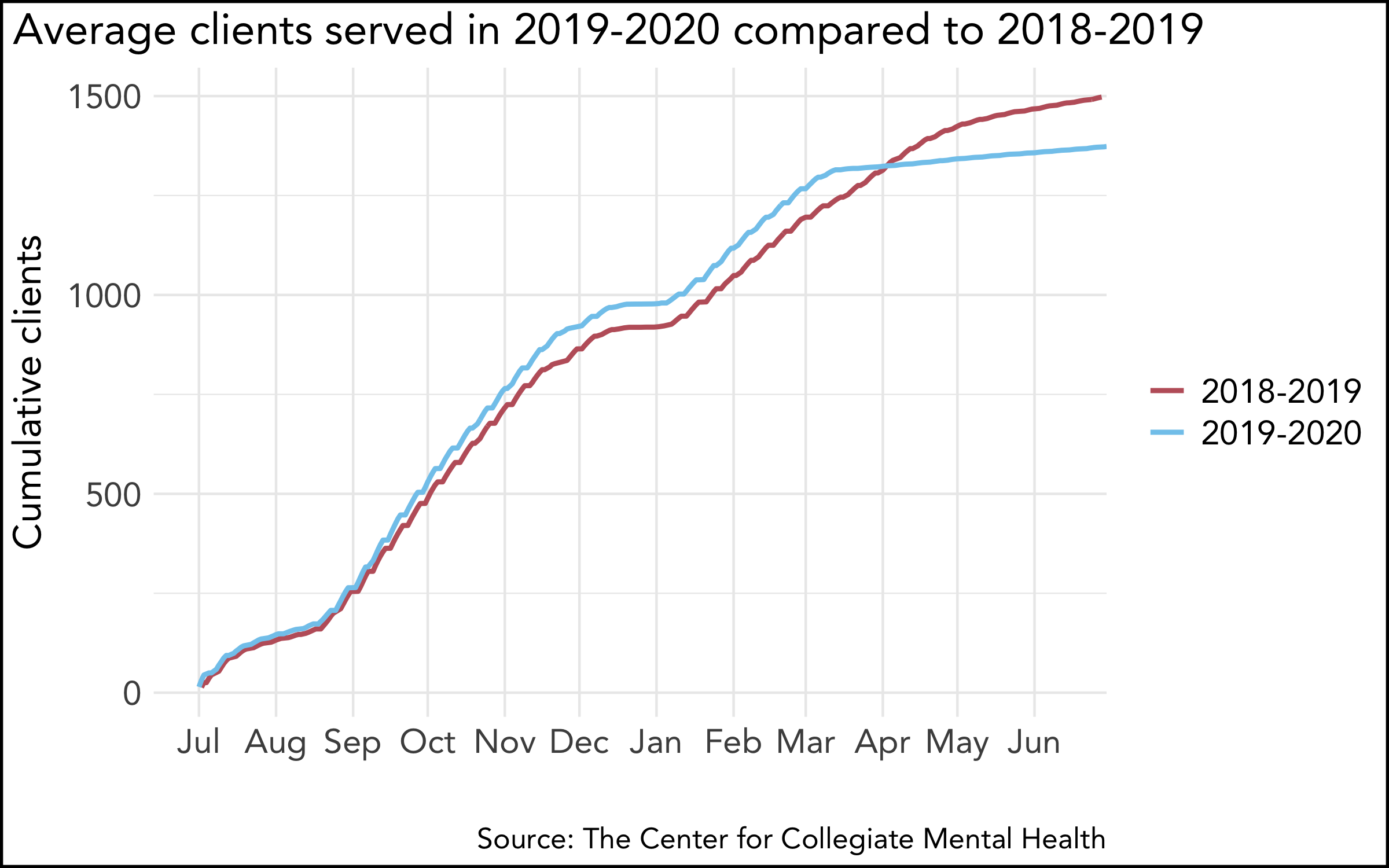
Moving ahead in time to Fall 2020, many predicted that there would be a surge of students seeking mental health services in the 2020-2021 academic year, beginning July 1st, 2020. The chart below compares the cumulative average number of students who received services during Fall 2020 (blue) to Fall 2019 (red). Again, the chart is cumulative, starting at zero on July 1st and increasing thereafter. The data show there was an average decrease of 32% in the number of unique students treated at counseling centers from Fall 2019 to Fall 2020.
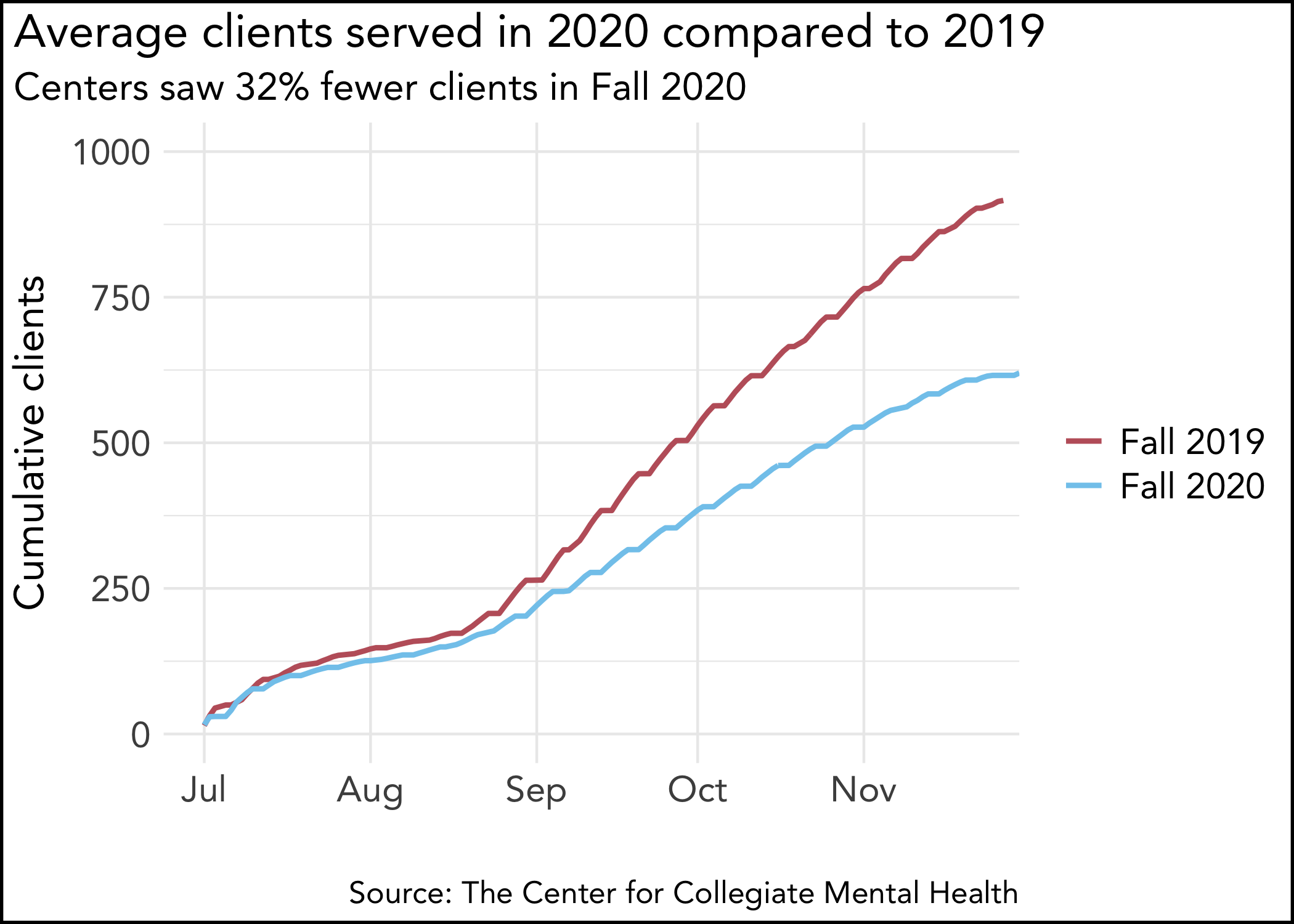
While averages provide an important perspective on any given point of measurement, they also tend to hide significant diversity. To explore the same data from a perspective that illustrates the diversity of counseling center experiences, the chart below visualizes the percent change in students served using a two-week rolling average over 18 months (July 1, 2019 to November 30, 2020). Individual centers are displayed as light gray lines with the average of these lines represented as a solid line (green/red). Like the cumulative average charts above, this chart shows that counseling centers were serving more unique students throughout the 2019-2020 academic year until COVID-19 emerged. After the onset of COVID-19 in March 2020, student help-seeking decreased on average during the spring, stabilized during Summer 2020, and decreased again in Fall 2020 when compared to the prior year. This chart shows that while the majority of centers experienced a decline in students seeking treatment after the onset of COVID-19, some centers did experience an increase.
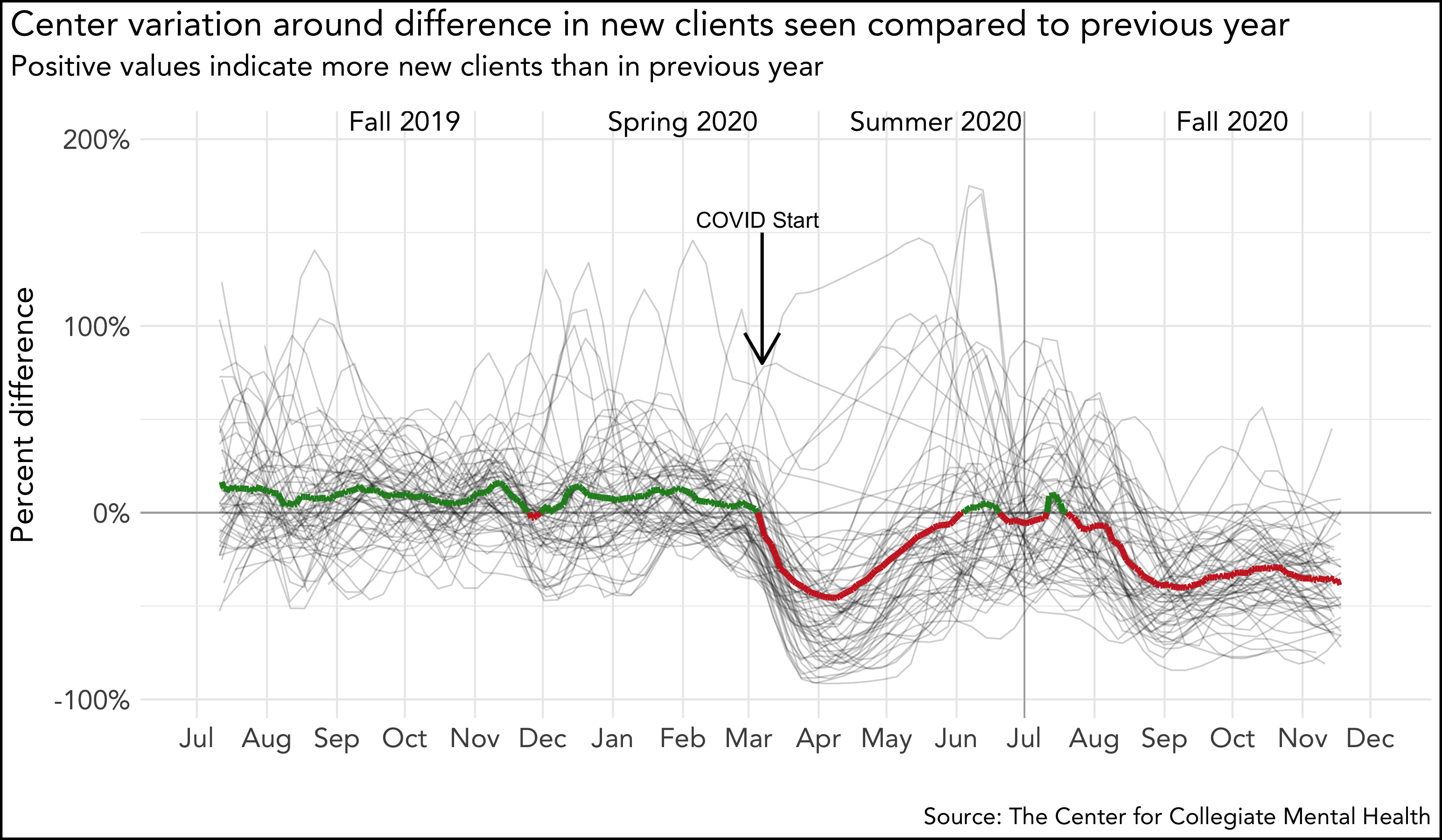
Did the average number of appointments attended by clients at college counseling centers change after the onset of COVID-19?
The charts in the section above examined how the number of students seeking mental health services changed after the onset of COVID-19. The group of charts in this next section will explore how the number of attended appointments were impacted by COVID-19. The first chart illustrates the cumulative average number of appointments attended during the 2018-2019, 2019-2020, and half of the 2020-2021 academic years. The data is cumulative, which starts at zero on July 1st of each year and then increases over time as more appointments are attended. This chart shows that counseling centers were providing more appointments in 2019-2020 compared to 2018-2019, but this trend flipped after the onset of COVID-19 in March 2020.
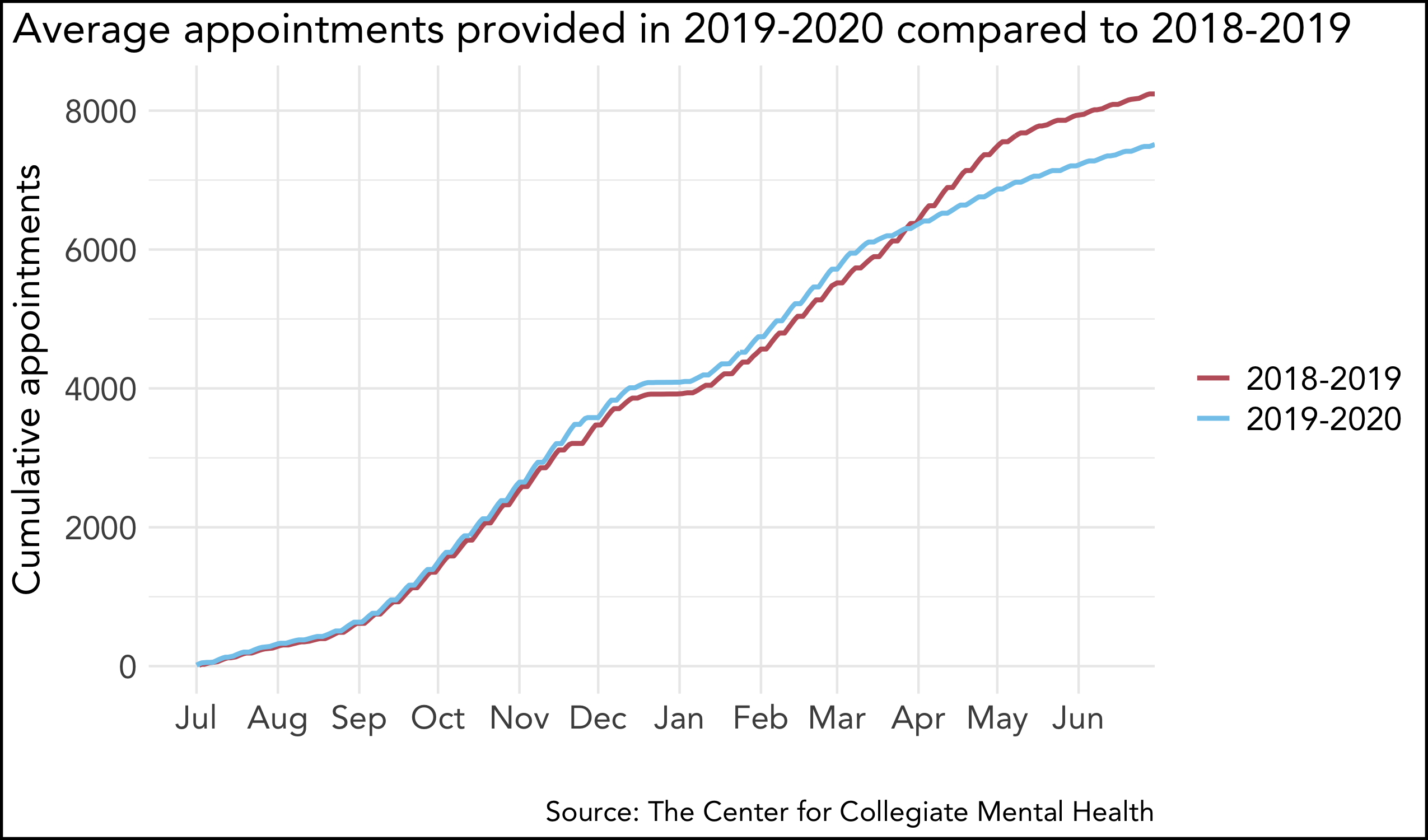
Moving ahead in time to Fall 2020, the next chart illustrates the cumulative average number of appointments provided in Fall 2020 compared to Fall 2019. Again, the data is cumulative, which starts at zero on July 1st and accrues thereafter. The data show that there was an average decrease of 19% in the number of attended appointments from Fall 2019 to Fall 2020. It is important to note that the 19% decrease in attended appointments was substantially less than the 32% decline in students served, which suggests that those who sought services in Fall 2020 received more care.
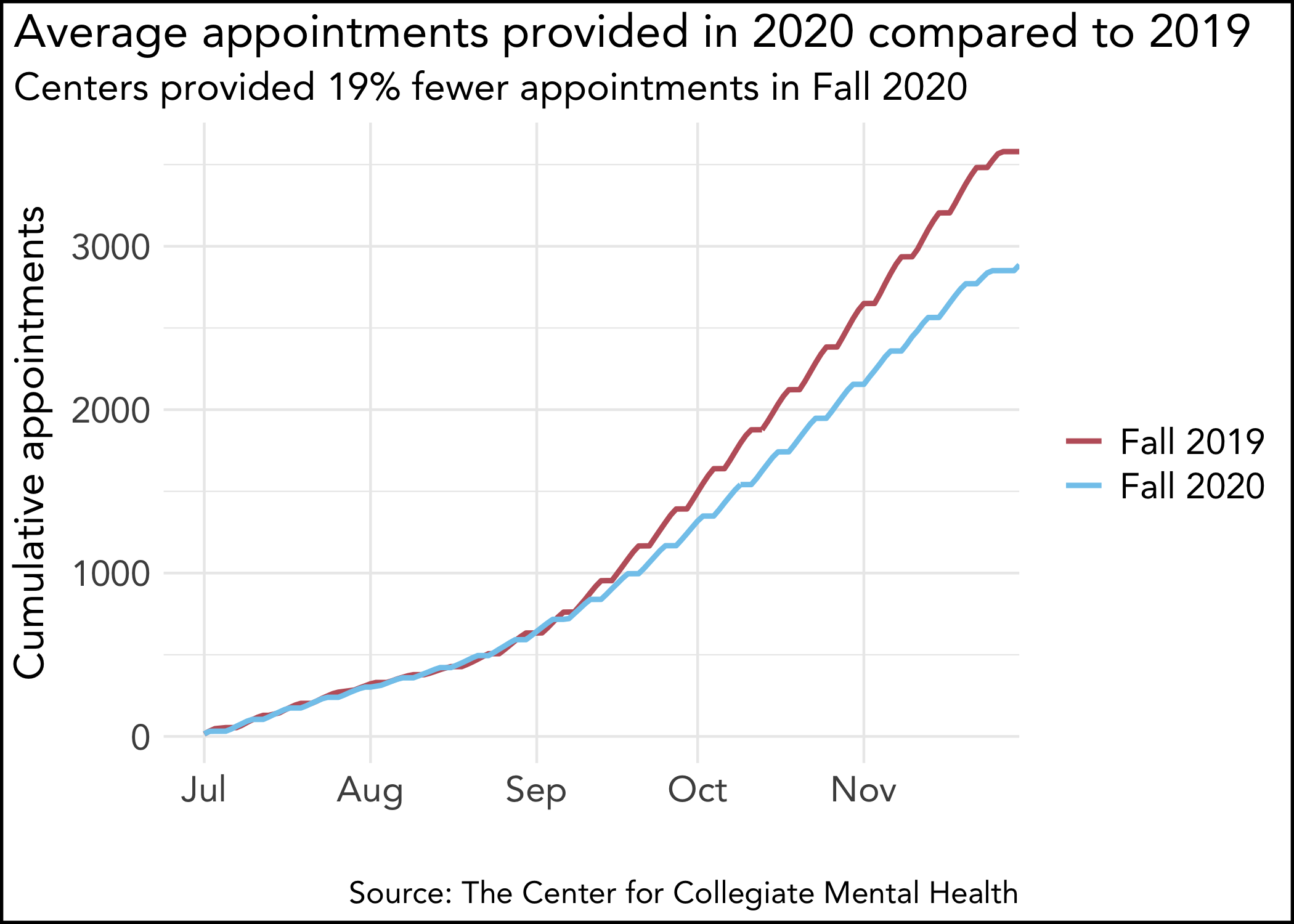
Again, to visualize the diversity of counseling center experiences during COVID-19, the next chart illustrates the year-to-year percent change in attended appointments at 63 counseling centers, using a two-week rolling average over 18 months (July 1, 2019 to November 30, 2020). Individual centers are again displayed as light gray lines with the average of these lines represented as a solid line (green/red). Like the cumulative average charts above, this chart shows that counseling centers were providing more appointments during the 2019-2020 academic year until COVID-19. However, after the onset of COVID-19 in March 2020, the average number of attended appointments decreased during the spring, stabilized during Summer 2020, and decreased again during Fall 2020. While the majority of centers experienced a decline in attended appointments after the onset of COVID-19, there is significant variability across centers, with some showing an increase in the number of attended appointments.

Did the average number of appointments per student change after the onset of COVID-19?
Year-to-Year Change in the Average Number of Appointments
Again, using data from 177,524 clients at 63 counseling centers, the average number of all attended appointments (intake, triage, individual counseling, group counseling, case management, psychiatry, etc.) per client increased from 3.91 (Fall 2019) to 4.66 (Fall 2020). In other words, the average student seeking mental health services received approximately 20% more services after the onset of COVID-19 than before.
Summary and Suggestions
In this blog, Part 4 of 5, CCMH examined changes in counseling center utilization (students served) and services provided (attended appointments) before and after the onset of COVID-19. Takeaway findings include:
- In the 2019-2020 academic year, the average counseling center served more unique students (compared to 2018-2019) until the onset of COVID-19 when the number of new students seeking services slowed dramatically. During Fall 2020, there was a 32% average decrease in the number of unique students seeking mental health services compared to the Fall of 2019. There was significant variability in year-to-year differences across centers, with some centers experiencing an increase in demand.
- In academic year 2019-2020, the average counseling center provided more appointments (compared to 2018-2019) until the onset of COVID-19. During Fall 2020, there was a 19% average decrease in the number of attended appointments compared to Fall 2019. While the average center experienced a decline in the number of attended appointments, there was significant variability among centers, with some centers delivering more appointments than the year prior.
- When comparing Fall 2020 to Fall 2019, the 19% decrease in attended appointments was substantially less than the 32% decrease in students treated. As a result, students seeking mental health services in Fall 2020 actually received an average of 20% more services compared to students seeking treatment in Fall 2019.
Following the onset of COVID-19 in March 2020 and the observed negative impacts on college students, many predicted that colleges and universities would experience a surge in students seeking mental health care during the Fall of 2020. Contrary to this prediction, and despite significant center-level variability, most college counseling centers experienced a decline in both students seeking services and appointments provided during Fall 2020 compared to Fall 2019. As highlighted in Blogs 1, 2, and 3, this trend is certainly not the result of diminished mental health concerns, student distress, or the lack of negative impacts on students.
Rather, it seems likely that useful explanations lay within broader higher education trends resulting from COVID-19. For example, almost all colleges and universities transitioned to remote instruction after the onset of COVID-19 and closed campuses in March 2020. The fact that these students, living at home, sought mental health services from distant campuses at a lower rate makes sense; people tend to seek help where they live. Similarly, the decline in counseling center utilization directly parallels the reduction in residential living observed during Fall 2020, as most colleges and universities significantly reduced on-campus residential capacities in response to COVID-19 requirements for physical distancing. In addition, a portion of the decrease might be related to the known barriers to accessing tele-health services, such as limited availability of private spaces to attend appointments, a strong preference for in-person services, and variable access to reliable required technologies. Finally, many students were attending their college while living in a different state. Because state-by-state licensing laws govern/limit mental health providers, students residing in a different state would often be ineligible for services and required to seek treatment closer to home.
Perhaps most importantly, the data reviewed here revealed a unique silver lining in the time of COVID-19: the average student who sought mental health care in Fall 2020 received 20% more treatment (appointments) than the average student in Fall 2019. This is truly great news for students treated by counseling centers this year. In addition, this unexpected finding represents a unique test of the theory that recent challenges in accessing mental health treatment on campus (waits for service, limits on length of treatment, etc.) have been caused by rapidly growing demand (by students) without commensurate growth in supply (of providers). Testing this theory at the national level (universally changing demand or supply) was effectively impossible without a national event that impacted all colleges and universities. The sudden onset of COVID-19 caused organized national changes in higher education, including a systematic drop in demand for institutionally-provided mental health services and a corresponding increase in the average dosage of treatment provided.
Please stay tuned for Part 5 of the CCMH COVID-19 Blog series where we will explore how counseling centers navigated the transition to remote operations.

